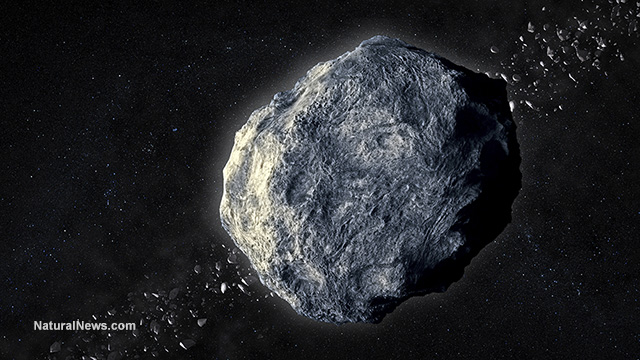Study: Mysterious bright light spotted in February was a distant star being squeezed by a black hole
12/13/2022 / By Kevin Hughes

The mysterious bright light spotted in February was a distant star being “squeezed like a toothpaste tube” by a colossal black hole, according to a study.
Astronomers working at the Zwicky Transient Facility in California were bewildered when they saw a flash that let out more light than a trillion suns last February. They have now determined that the light was due to a tidal disruption event (TDE) where a star drifts too close to a black hole and is torn apart by gravitational forces.
The February 2022 TDE, known as AT2022cmc, is deemed as one of the most intense events in the universe. It happened more than eight billion light-years away, making it the most distant TDE ever discovered.
Moreover, AT2022cmc is the fourth Doppler-boosted TDE ever identified and the first such event that has been witnessed since 2011. It is also the first TDE found using an optical sky survey. Data gathered from it could help take a new look on how immense black holes feed and grow. (Related: Supermassive black hole at the center of our galaxy emits mysterious burst of radiation, growing brighter.)
The flash, known as a jetted TDE, was first identified during a regular all-sky survey, and was discovered as a jet of light aiming directly toward Earth. After the destruction of the star, a discharge of matter flashed out of the black hole at near the speed of light, expanding along its axis of rotation.
This discharged X-ray radiation, which was absorbed by dust encircling the black hole, was re-discharged as infrared radiation, radio waves and visible light.
The jet’s strange brightness and alignment toward Earth permitted instruments around the world to capture it in unexpected detail, in spite of its vast distance away from the planet. These included the Liverpool Telescope in Spain and European Southern Observatory’s Very Large Telescope in Chile.
“We have only seen a handful of these jetted TDEs and they remain very exotic and poorly understood events,” said Nial Tanvir from the University of Leicester, who was taking part in the analysis.
AT2022cmc is an “extraordinary” type of TDE
According to Dr. Daniel Perley, a co-author from Liverpool John Moores University, AT2022cmc was an “extraordinary” type of TDE that “didn’t seem to match any known type of celestial source.”
“The most known types of explosions are either much faster, much slower, or much bluer in color than inferred from the data. Usually, intense gravitational forces tear the star apart, transforming it into a superheated disk of gas which eventually disappears into the black hole. However, in this case, something happened that ejected matter almost at the speed of light back into space,” Perley said.
“The way we describe it is as a toothpaste tube being squeezed suddenly in the middle causing the contents to squirt matter out of both ends. Then, as the material collides with surrounding gas, the intense optical, radio, and X-ray emission is produced.”
As reported by Dr. Dheeraj Pasham, co-author and astrophysicist at the Massachusetts Institute of Technology (MIT), the research team was able to “catch this event right at the beginning, within one week of the black hole starting to feed on the star.”
“Until now, the small number of jetted TDEs that are known were initially detected using high energy gamma ray and X-ray telescopes,” Perley added.
“As bright as they are, there is only so much light a collapsing star can produce. Because AT 2022cmc was so bright and lasted so long, we knew that something truly gargantuan must be powering it – a supermassive black hole,” said Dr. Benjamin Gompertz, from the University of Birmingham who headed the analysis. His team concluded that the extreme X-ray activity is the result of the shredded star creating a whirlpool of debris as it fell into the black hole.
Follow Space.news for more news about incredible space phenomena.
Watch this video about scientists capturing an image of a black hole at the center of Milky Way.
This video is from the In Search Of Truth channel on Brighteon.com.
More related stories:
Challenging assumptions about the universe: Study suggests black holes could be made of dark energy.
A massive star went missing without leaving any trace, astronomers say.
Some black holes bring dead “zombie” stars back to life just to rip them apart later.
Sources include:
Submit a correction >>
Tagged Under:
AT2022cmc, black hole, breakthrough, cosmic, discoveries, gamma ray, gravitational forces, infrared radiation, optical light, radio waves, real investigations, research, Space, space tourism, Star, TDE, tidal disruption event, X-ray radiation
This article may contain statements that reflect the opinion of the author
RECENT NEWS & ARTICLES
COPYRIGHT © 2017 SPACE.COM
All content posted on this site is protected under Free Speech. Space.com is not responsible for content written by contributing authors. The information on this site is provided for educational and entertainment purposes only. It is not intended as a substitute for professional advice of any kind. Space.com assumes no responsibility for the use or misuse of this material. All trademarks, registered trademarks and service marks mentioned on this site are the property of their respective owners.




















